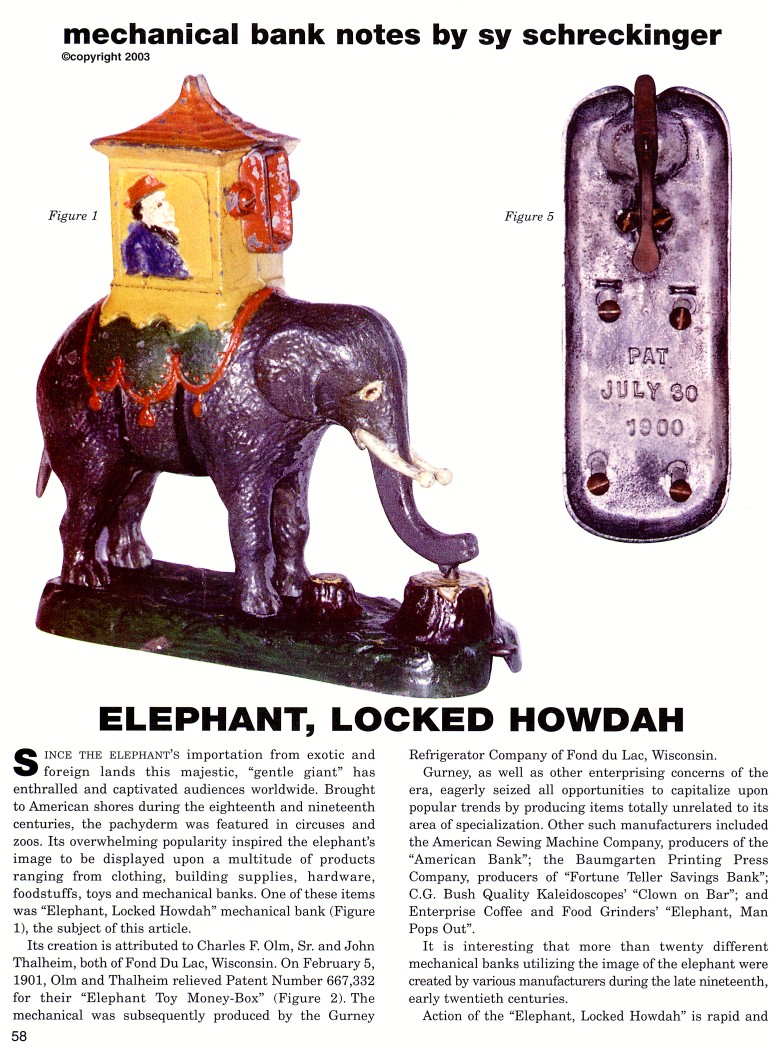|
Elephant, Locked Howdah
by Sy Schreckinger – ANTIQUE TOY WORLD Magazine – December, 2003
Since the Elephant's importation from exotic and
foreign lands this majestic, "gentle giant" has enthralled and captivated
audiences worldwide. Brought to American shores during the eighteenth and
nineteenth centuries, the pachyderm was featured in circuses and zoos. Its
overwhelming popularity inspired the elephant's image to be displayed upon
a multitude of products ranging from clothing, building supplies,
hardware, foodstuffs, toys and mechanical banks. One of these items was
"Elephant, Locked Howdah" mechanical bank (Figure 1), the subject of this
article.
Its creation is attributed to Charles F. Olm, Sr. and John Thalheim,
both of Fond Du Lac, Wisconsin. On February 5, 1901, Olm and Thalheim
relieved Patent Number
667,332 for their "Elephant Toy Money-Box" (Figure
2). The mechanical was subsequently produced by the Gurney Refrigerator
Company of Fond du Lac, Wisconsin.
Gurney, as well as other enterprising concerns of the era, eagerly
seized all opportunities to capitalize upon popular trends by producing
items totally unrelated to its area of specialization. Other such
manufacturers included the American Sewing Machine Company, producers of
the "American Bank"; the Baumgarten Printing Press Company, producers of
"Fortune Teller Savings Bank"; C.G. Bush Quality Kaleidoscopes' "Clown on
Bar"; and Enterprise Coffee and Food Grinders' "Elephant, Man Pops Out".
It is interesting that more than twenty different mechanical banks
utilizing the image of the elephant were created by various manufacturers
during the late nineteenth, early twentieth centuries.
Action of the "Elephant, Locked Howdah" is rapid and decisive. Its
trunk is first pulled downward and snapped into place. A coin is then
inserted within the provided slot at the end of the appendage. The lever
protruding from the front of the base is depressed, releasing the
proboscis. This propels the coin into the howdah. Deposits are retrieved
by opening a square key lock coin retainer located in the side of the
howdah.
At this time, I am aware of the three casting variations involving
the key lock of "Elephant, Locked Howdah". One has the word "BANK" in
raised letters above the keyhole. The other has no wordage, while the
third variant, seen in Figure 1, was produced with a completely sealed
howdah and no key lock. This particular example requires the elephant to
be completely disassembled and removed from its base in order to recover
coin deposits. Such complicated coin removal may indicate it was an early
production example in need of redesign for less complex coin recovery.
In addition, early "Elephant, Locked Howdah" banks produced without
the locking coin retainer were constructed almost entirely of a lead
alloy. The activating lever and a few small reinforcement parts were,
however, fashioned of cast iron. All later original production examples
were constructed entirely of cast iron.
"Elephant, Locked Howdah" has been reproduced, and its construction
is entirely of cast iron. Fortunately, these are easily discernible, as
illustrated in Figure 3. All reproductions exhibit only one tree stump on
the base. The original banks have two...a large tree stump at the
forefront and a smaller one just forward of the elephant's front legs.
Another method of detecting a fraudulent example is seen in Figure 4. The
activating lever underneath the base is created from a strip of spring
steel rather than the original's finely cast iron counterpart, seen in
Figure 5. Interestingly, the base of the reproduced "Elephant, Locked
Howdah" more closely reflects the one pictured in the patent design
(Figure 2), which exhibits a single tree stump and a flat activating
lever.
Figure 5 illustrates the underside of an original example "Elephant,
Locked Howdah". Although the patent date seen differs from that indicated
in the actual patent papers, it was, nevertheless, helpful in locating
pertinent information.
Figure 6 represents a base diagram of an original example "Elephant,
Locked Howdah" mechanical bank. It is provided solely to indicate size and
scale. Unfortunately, bases of the reproduced examples are identical in
size to the original and, therefore, cannot be used to
determine authenticity.
Acknowledgement: The fine example "Elephant, Locked Howdah" (Figure
1) is in the collection of Robert E. Weiss, and is the same example that
is pictured on page 30 of the "Bill Norman Bank Book".
|


